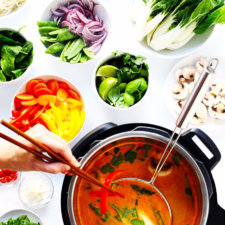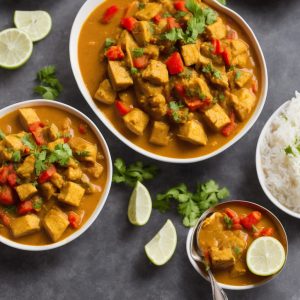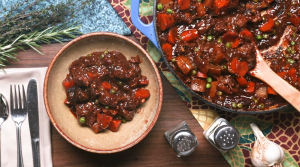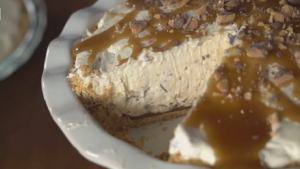Looking to try something spicy, aromatic, and exotic? This Indian shrimp curry recipe is a delightful mix of succulent shrimp and aromatic Indian spices, simmered in a creamy coconut sauce. The dish is vibrant, flavorful, and will definitely add a touch of elegance to your dinner table.
Some of the ingredients in this recipe such as ground ginger, curry powder, ground coriander, and lite coconut milk might not be a staple in your pantry. These can be easily found in the international aisle of most supermarkets. If you prefer, you can also substitute them with fresh counterparts. For example, fresh ginger can replace ground ginger.
Ingredients for Indian Shrimp Curry Recipe
Canola oil: This oil is used for sautéing the shrimp and onion due to its neutral taste.
Shrimp: The star ingredient of this recipe, providing a delicate, slightly sweet flavor.
Yellow onion: Adds a sweet and tangy flavor that complements the spices.
Ground ginger: Brings a fresh, zingy flavor.
Ground cumin: Contributes an earthy, savory note.
Ground coriander: Imparts a floral, citrusy character.
Ground turmeric: Gives the dish its vibrant yellow color and a subtle bitterness.
Curry powder: A blend of spices that gives the curry its distinctive, warm flavor.
Paprika: Adds sweetness and color.
Chili powder: Provides a hint of heat to balance out the flavors.
Garlic cloves: Enhances the overall flavor profile.
Tomato sauce: Creates a tangy and rich base for the curry.
Lite coconut milk: Adds creaminess and a hint of tropical flavor.
Kosher salt: Used for seasoning.
Cilantro: Offers a bright, citrusy finish.
Chili peppers: For garnishing and extra heat, if desired.
One reader, Amil Eason says:





This Indian shrimp curry recipe is a game-changer! The blend of spices creates an explosion of flavors, and the creamy coconut milk adds a delightful richness. The shrimp is perfectly tender, and the dish is so easy to make. It's a definite winner for any dinner party!
Key Techniques for Making Indian Shrimp Curry
How to cook the shrimp: Briefly explain the process of cooking the shrimp, including the time and temperature required to cook them properly.
How to sauté the onions: Describe the technique for sautéing the onions, including the ideal pan temperature and the desired level of caramelization.
How to combine the spices: Explain the best method for combining the various spices to ensure even distribution and flavor infusion.
How to adjust the seasoning: Provide guidance on tasting and adjusting the seasoning to achieve the desired flavor profile.
How to garnish with cilantro and chili peppers: Describe the process of garnishing the dish with cilantro and chili peppers for both visual appeal and added flavor.
How To Make Indian Shrimp Curry
This easy Indian shrimp curry is simmered in a creamy coconut and tomato sauce, then serve with chili peppers, for a rich and filling meal!
Serves:
Ingredients
- 1tbspcanola oil,divided
- 1lbshrimp,peeled, deveined
- ½yellow onion,finely chopped
- 1tspground ginger
- 1tspground cumin
- 1tspground coriander
- 1½tspground turmeric
- 1tspcurry powder
- 1tsppaprika
- ½tspchili powder
- 2garlic cloves,minced
- 15oztomato sauce
- ¾cuplite coconut milk,canned
- ½tspkosher salt
- cilantro,for garnish
- chili peppers,for garnish
Instructions
-
Add 2 teaspoons of the canola oil on high heat in a large skillet. Add the shrimp, then cook for 1 minute on each side. Remove the shrimp from the pan.
-
Place the remaining teaspoon of the canola oil to the skillet with the onions. Cook the onions for about 5 minutes on medium heat, stirring occasionally.
-
Add in the ginger, cumin, coriander, turmeric, paprika, curry powder, chili powder, salt, and garlic. Stir well, letting it cook for 30 seconds.
-
Pour in the tomato sauce and combine. Then, pour in the coconut milk and shrimp to the pan, and stir well.
-
Garnish with cilantro and chili peppers, serve, and enjoy!
Nutrition
- Calories: 195.68kcal
- Fat: 8.46g
- Saturated Fat: 2.94g
- Trans Fat: 0.03g
- Monounsaturated Fat: 2.69g
- Polyunsaturated Fat: 1.60g
- Carbohydrates: 12.58g
- Fiber: 3.25g
- Sugar: 5.87g
- Protein: 17.70g
- Cholesterol: 142.88mg
- Sodium: 1169.45mg
- Calcium: 101.10mg
- Potassium: 585.42mg
- Iron: 2.86mg
- Vitamin A: 117.97µg
- Vitamin C: 22.39mg
Crucial Technique Tip for Perfecting Indian Shrimp Curry
When cooking the shrimp, ensure that you don't overcook them as they can become tough and lose their succulent flavor. Shrimp cook very quickly, usually in about 1-2 minutes per side, and you'll know they're done when they turn pink and opaque. Also, when adding the spices, make sure to stir them well to evenly distribute the flavors throughout the dish. This will ensure that every bite is packed with the rich, aromatic flavors of the curry.
Time-Saving Tips for Preparing Indian Shrimp Curry Recipe
Prep ahead: Chop vegetables and measure out spices in advance to streamline the cooking process.
One-pot wonders: Opt for recipes that require minimal pots and pans to reduce cleanup time.
Batch cooking: Make a larger quantity of the curry and freeze the extra portions for quick and convenient future meals.
Efficient multitasking: While the curry simmers, use the time to prepare a side dish or set the table to maximize productivity in the kitchen.
Quick cleanup: Clean as you go to minimize the post-cooking cleanup time, making the process more efficient.
Substitute Ingredients For Indian Shrimp Curry Recipe
canola oil - Substitute with vegetable oil: Vegetable oil is a neutral-flavored oil that can be used as a substitute for canola oil in cooking.
shrimp - Substitute with firm white fish (such as cod or halibut) or tofu: Firm white fish or tofu can be used as a substitute for shrimp to create a similar texture and absorb the flavors of the curry.
yellow onion - Substitute with white onion or shallots: White onion or shallots can be used as a substitute for yellow onion to provide a slightly different flavor profile while still adding a savory element to the dish.
ground ginger - Substitute with fresh grated ginger: Fresh grated ginger can be used as a substitute for ground ginger to provide a more intense and fresher ginger flavor to the curry.
ground cumin - Substitute with ground coriander: Ground coriander can be used as a substitute for ground cumin to add a warm and citrusy flavor to the curry.
ground coriander - Substitute with ground cumin: Ground cumin can be used as a substitute for ground coriander to add a slightly different earthy and nutty flavor to the curry.
ground turmeric - Substitute with curry powder: Curry powder can be used as a substitute for ground turmeric to provide a similar vibrant color and warm, aromatic flavor to the dish.
curry powder - Substitute with garam masala: Garam masala can be used as a substitute for curry powder to add a different blend of warm and aromatic spices to the curry.
paprika - Substitute with cayenne pepper: Cayenne pepper can be used as a substitute for paprika to add a spicy kick to the curry.
chili powder - Substitute with red pepper flakes: Red pepper flakes can be used as a substitute for chili powder to add heat and a slightly different texture to the curry.
garlic cloves - Substitute with garlic powder: Garlic powder can be used as a substitute for garlic cloves to provide a similar garlic flavor without the texture of minced or chopped garlic.
tomato sauce - Substitute with diced tomatoes: Diced tomatoes can be used as a substitute for tomato sauce to add a chunkier texture and a fresher tomato flavor to the curry.
lite coconut milk - Substitute with unsweetened coconut milk: Unsweetened coconut milk can be used as a substitute for lite coconut milk to provide a richer and creamier texture to the curry.
kosher salt - Substitute with sea salt: Sea salt can be used as a substitute for kosher salt to provide a similar level of saltiness to the dish.
cilantro - Substitute with parsley: Parsley can be used as a substitute for cilantro to add a fresh, herbaceous flavor to the curry.
chili peppers - Substitute with jalapeños: Jalapeños can be used as a substitute for chili peppers to add heat and a slightly different flavor profile to the curry.
Presentation Ideas for Indian Shrimp Curry
Elevate the plating: When presenting the Indian shrimp curry, focus on creating an elegant and visually appealing presentation. Use clean, white plates to allow the vibrant colors of the curry to stand out. Arrange the shrimp curry neatly in the center of the plate, ensuring that each element is showcased beautifully.
Garnish with precision: Add a final touch of sophistication by garnishing the dish with finely chopped fresh cilantro and thinly sliced chili peppers. These garnishes not only enhance the visual appeal but also add a pop of freshness and flavor to the dish.
Incorporate artistic drizzling: Elevate the presentation further by incorporating artistic drizzling techniques with the coconut milk. Use a squeeze bottle to create delicate swirls or patterns around the edges of the plate, adding a touch of finesse to the overall presentation.
Balance the elements: Pay attention to the balance of the dish on the plate. Ensure that the shrimp, curry sauce, and garnishes are proportionally distributed, creating a harmonious and visually striking composition.
Emphasize cleanliness and precision: Prioritize cleanliness and precision in every aspect of the presentation. Wipe any smudges or spills on the plate, and use tweezers or small utensils to position the garnishes with meticulous attention to detail.
Consider complementary side dishes: If serving the Indian shrimp curry as part of a larger meal, consider incorporating complementary side dishes such as fragrant basmati rice or warm naan bread. Arrange these accompaniments thoughtfully around the main dish to create a cohesive and inviting presentation.
Highlight the aromatics: Before presenting the dish, take a moment to appreciate the aromatic elements of the curry. Encourage the judges to savor the enticing aroma that emanates from the perfectly spiced shrimp curry, setting the stage for a sensory culinary experience.
Essential Kitchen Tools for Making Shrimp Curry
- Cutting board: A flat, sturdy surface used for cutting and preparing ingredients.
- Chef's knife: A versatile, all-purpose knife used for chopping, slicing, and dicing various ingredients.
- Skillet: A frying pan with a flat bottom and sloping sides, used for sautéing, frying, and searing.
- Wooden spoon: A cooking utensil with a long handle and a rounded head, commonly used for stirring and mixing ingredients.
- Measuring cups and spoons: Essential tools for accurately measuring ingredients in cooking and baking.
- Spice grinder: Used to grind whole spices into fine powders for adding flavor to dishes.
- Garlic press: A tool used to crush and mince garlic cloves for easy incorporation into recipes.
- Grater: Used to grate or shred ingredients such as cheese, vegetables, or citrus zest.
- Mixing bowl: A bowl used for combining and mixing ingredients during food preparation.
- Whisk: A kitchen utensil used for blending, whipping, and incorporating air into ingredients.
- Can opener: A tool used to open canned goods by cutting the lid away from the can's rim.
- Saucepan: A deep cooking vessel with a handle and a lid, used for heating and cooking sauces, soups, and other liquids.
- Tongs: Kitchen utensils with two arms and a pivot, used for gripping and lifting hot or delicate items.
- Immersion blender: A handheld blending device used for puréeing soups, sauces, and other liquids directly in the cooking pot.
- Colander: A perforated bowl-shaped kitchen utensil used for draining liquids from food items.
- Ladle: A long-handled spoon with a deep bowl, used for serving soups, stews, and sauces.
- Baking sheet: A flat, rectangular metal pan used for baking and roasting a variety of foods in the oven.
- Pastry brush: A cooking utensil with bristles, used for applying glazes, sauces, or butter to food items.
- Food processor: A versatile kitchen appliance used for chopping, blending, and puréeing ingredients.
Storage and Freezing Instructions for Indian Shrimp Curry
- Let the shrimp curry cool completely before storing it in an airtight container in the refrigerator. It will keep well for up to 3-4 days.
- If you want to freeze the curry, transfer it to a freezer-safe container or a resealable plastic bag. Make sure to remove as much air as possible before sealing to prevent freezer burn.
- Label the container or bag with the date and contents, so you can easily keep track of when it was frozen.
- When you're ready to enjoy the frozen curry, thaw it overnight in the refrigerator.
- Reheat the curry in a saucepan over medium-low heat, stirring occasionally, until it's heated through. You may need to add a splash of coconut milk or water to thin out the sauce if it has thickened during storage.
- Note: The texture of the shrimp may change slightly after freezing and thawing, but the flavors will still be delicious.
- For best results, consume the frozen curry within 2-3 months for optimal taste and texture.
How To Reheat Leftover Indian Shrimp Curry
Reheat the shrimp curry in a saucepan over medium-low heat, stirring occasionally, until it reaches the desired temperature. This method ensures that the flavors meld together and the sauce thickens slightly, creating a more intense and delicious taste experience.
For a quicker reheating option, use the microwave. Transfer the leftover curry to a microwave-safe dish and cover it with a damp paper towel to prevent splatters. Heat the curry in 30-second intervals, stirring between each interval, until it's heated through. Be careful not to overheat, as this can cause the shrimp to become rubbery.
If you have leftover rice or naan bread, you can create a delightful new dish by stir-frying them with the leftover shrimp curry. Heat a tablespoon of oil in a large skillet or wok, add the rice or chopped naan, and stir-fry for a couple of minutes. Add the leftover curry and continue stir-frying until the rice or naan is crispy and the curry is heated through. This method creates a flavorful and texturally exciting dish that breathes new life into your leftovers.
For a more adventurous approach, transform your leftover shrimp curry into a delectable filling for tacos or burritos. Reheat the curry using one of the above methods, then spoon it into warm tortillas. Top with fresh cilantro, diced onions, and a squeeze of lime juice for a fusion of Indian and Mexican flavors that will tantalize your taste buds.
Interesting Trivia About Indian Shrimp Curry
The Indian shrimp curry recipe is a popular dish in coastal regions of India, where seafood is abundant. Shrimp is a good source of protein and is low in calories, making it a healthy choice for a curry dish. The combination of spices used in this recipe, such as turmeric, cumin, and coriander, not only adds flavor but also provides various health benefits. Turmeric, for example, contains curcumin, a compound with powerful anti-inflammatory and antioxidant properties. This makes the Indian shrimp curry not only delicious but also nutritious.
Is Making Indian Shrimp Curry at Home Cost-Effective?
The Indian shrimp curry recipe is quite cost-effective for a household. Shrimp is a relatively affordable protein, and the spices and ingredients used are commonly found in most kitchens. The dish offers a flavorful and satisfying meal for a family of four at an approximate cost of $20. The combination of spices and the use of coconut milk and tomato sauce adds depth and richness to the dish, making it a delicious and budget-friendly option. Overall Verdict: 9.
Is Indian Shrimp Curry Healthy?
This Indian shrimp curry recipe is a relatively healthy dish, thanks to its use of nutrient-dense ingredients like shrimp, tomato sauce, and spices. Shrimp is an excellent source of lean protein, while the spices used in the recipe, such as ginger, cumin, coriander, turmeric, and garlic, offer various health benefits due to their anti-inflammatory and antioxidant properties. The recipe also uses lite coconut milk, which reduces the overall calorie and fat content compared to regular coconut milk.
However, there are a few areas where the recipe could be improved to make it even healthier:
- Replace the canola oil with a healthier alternative like olive oil or avocado oil, which are rich in monounsaturated fats and have anti-inflammatory properties
- Increase the amount of vegetables in the dish by adding bell peppers, carrots, or spinach to boost the fiber and nutrient content
- Opt for low-sodium tomato sauce to reduce the overall sodium content of the dish
- Serve the curry with brown rice or quinoa instead of white rice to increase the fiber and nutrient content of the meal
- Use fresh herbs like cilantro and mint to add flavor and additional health benefits without increasing the calorie content
Editor's Opinion on This Indian Shrimp Curry Recipe
This Indian shrimp curry recipe is a delightful blend of aromatic spices and creamy coconut milk, creating a rich and flavorful dish. The combination of cumin, coriander, turmeric, and curry powder adds depth to the sauce, while the shrimp brings a delicate seafood flavor. The addition of chili peppers provides a subtle heat, balanced by the cooling effect of the cilantro. Overall, this dish is a harmonious fusion of Indian flavors that will surely tantalize the taste buds.
Enhance Your Indian Shrimp Curry Recipe with These Unique Side Dishes:
Similar Recipes to Try If You Enjoy Indian Shrimp Curry
Appetizer and Dessert Pairings for Indian Shrimp Curry
Why trust this Indian Shrimp Curry Recipe:
This recipe offers a delightful blend of flavors and spices, ensuring a mouthwatering experience. The use of fresh shrimp guarantees a delectable taste, while the combination of coconut milk and tomato sauce creates a rich and creamy texture. The aromatic blend of ginger, cumin, and coriander infuses the dish with authentic Indian flavors. The careful selection of ingredients and precise cooking instructions ensures a dish that is both flavorful and satisfying. Trust in this recipe to transport your taste buds to the vibrant and exotic world of Indian cuisine.
Was this page helpful?
Have your own special recipe to share? Submit Your Recipe Today!













